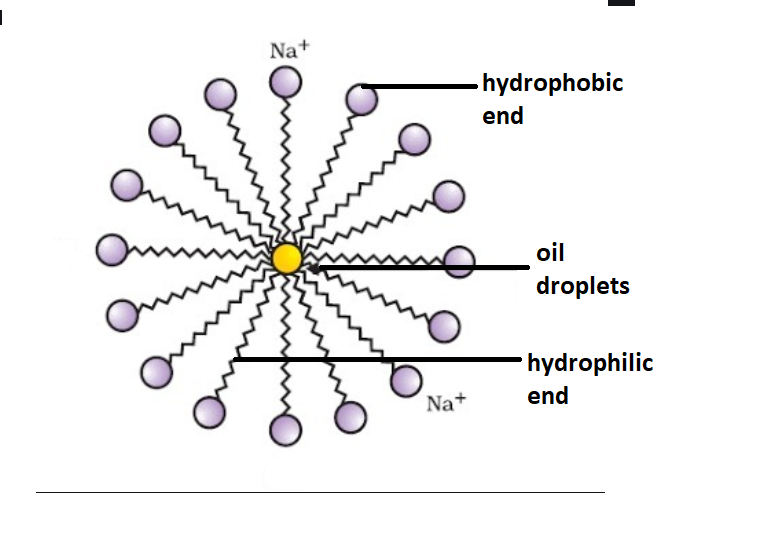
Answer
444.9k+ views
Hint: Soap: Soaps are sodium and potassium salts of long-chain fatty acids containing 12-18 carbon atoms. The general formula of soaps is $RCO{{O}^{-}}\text{ and N}{{\text{a}}^{+}}$ , where R = long-chain alkyl group.
Complete Solution :
- Soaps are prepared by a saponification reaction. Soaps are basically sodium or potassium salts of long-chain fatty acids such as palmitic acid, stearic acid, oleic acid, etc. in the industries the soaps are generally manufactured by heating fat with sodium hydroxide solution. Fats are nothing but triesters of glycerol and fatty acids.
- Glycerol is one of the organic compounds which contains around three carbon atoms and an OH group which are attached to each carbon atom, while fatty acids are long-chain carboxylic acids.
- We know that the soap molecules are present in water, the molecules arrange themselves as a cluster in which their hydrophobic ends are away from the water molecules, and their hydrophilic or also known as ionic ends are towards the water molecules. This whole process is known as micelle formation and the cluster formed by the soap molecules is called a micelle.

The polar head is hydrophilic while the nonpolar tail is hydrophobic. So the soap molecule in water is oriented with its head towards water and tail away from water.
As we know that like dissolves like so, the ionic end of soap dissolves in water while the carbon chain dissolves in oil.
So, the correct answer is “Option A”.
Note: The possibility to make a mistake is that you may choose option B. But an ionic end is a hydrophilic group (water-loving) and the alkyl chain is hydrophobic (water repellent).
Complete Solution :
- Soaps are prepared by a saponification reaction. Soaps are basically sodium or potassium salts of long-chain fatty acids such as palmitic acid, stearic acid, oleic acid, etc. in the industries the soaps are generally manufactured by heating fat with sodium hydroxide solution. Fats are nothing but triesters of glycerol and fatty acids.
- Glycerol is one of the organic compounds which contains around three carbon atoms and an OH group which are attached to each carbon atom, while fatty acids are long-chain carboxylic acids.
- We know that the soap molecules are present in water, the molecules arrange themselves as a cluster in which their hydrophobic ends are away from the water molecules, and their hydrophilic or also known as ionic ends are towards the water molecules. This whole process is known as micelle formation and the cluster formed by the soap molecules is called a micelle.

The polar head is hydrophilic while the nonpolar tail is hydrophobic. So the soap molecule in water is oriented with its head towards water and tail away from water.
As we know that like dissolves like so, the ionic end of soap dissolves in water while the carbon chain dissolves in oil.
So, the correct answer is “Option A”.
Note: The possibility to make a mistake is that you may choose option B. But an ionic end is a hydrophilic group (water-loving) and the alkyl chain is hydrophobic (water repellent).
Recently Updated Pages
Four boys picked up 30 mangoes In how many ways can class 10 maths CBSE

How do you prove Ptolemys Theorem that in a cyclic class 10 maths CBSE

How do you complete the ordered pair 0 given y 6x + class 10 maths CBSE

Write a letter to your grandparents describing the class 10 english CBSE

The ratio of radius of the nucleus to the radius of class 10 chemistry CBSE

How many atoms are in a gram of air class 10 chemistry CBSE

Trending doubts
Which are the Top 10 Largest Countries of the World?

How do you graph the function fx 4x class 9 maths CBSE

Fill the blanks with the suitable prepositions 1 The class 9 english CBSE

Difference between Prokaryotic cell and Eukaryotic class 11 biology CBSE

The Equation xxx + 2 is Satisfied when x is Equal to Class 10 Maths

Why is there a time difference of about 5 hours between class 10 social science CBSE

Differentiate between homogeneous and heterogeneous class 12 chemistry CBSE

What is pollution? How many types of pollution? Define it

Give 10 examples for herbs , shrubs , climbers , creepers




